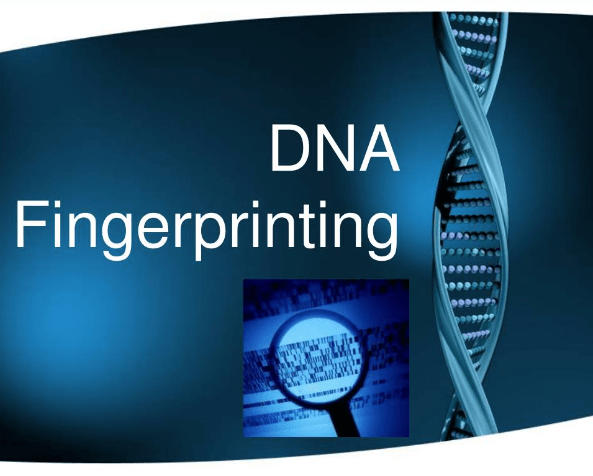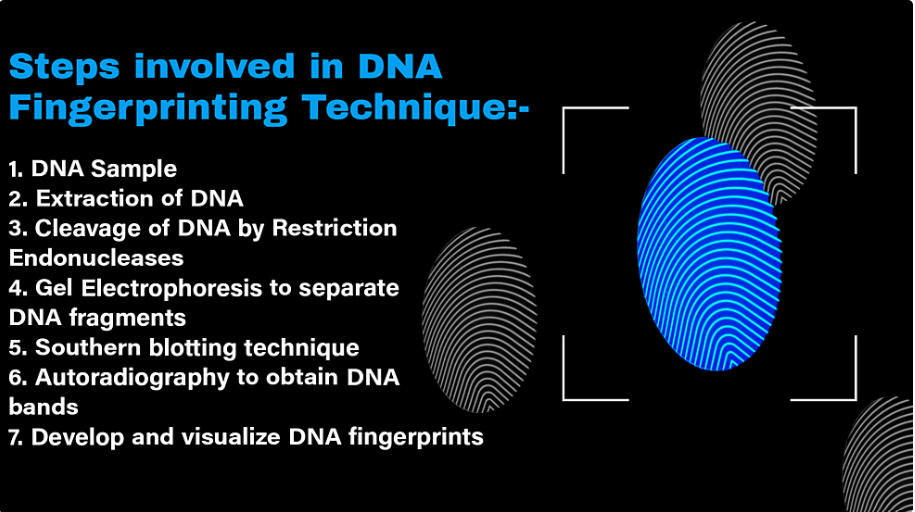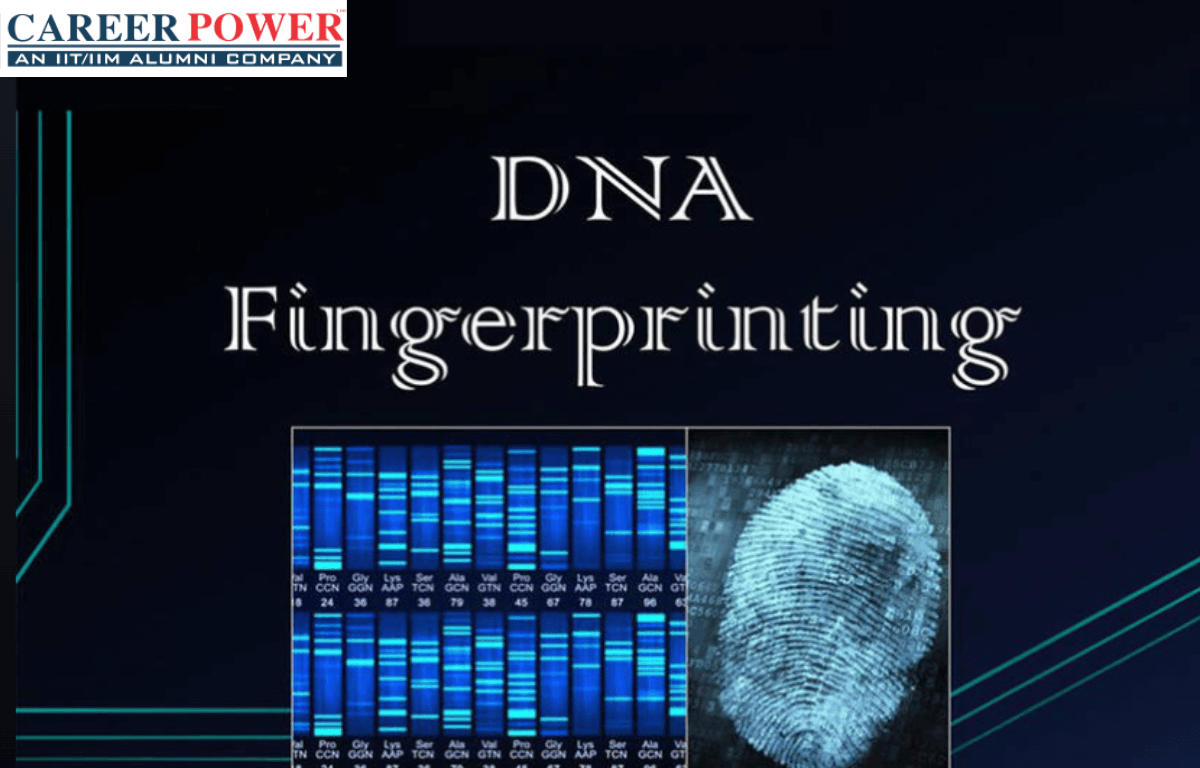Table of Contents
As we already know DNA is a very important topic of Biology not just for class 10th and 12th students but also for students preparing for the NEET 2024 examination. DNA fingerprinting is like giving each person a unique barcode made from their own DNA. Just like how no two fingerprints are exactly the same, our DNA has special patterns that are unique to each person.
Scientists use DNA fingerprinting methods to solve mysteries, like figuring out who committed a crime or finding long-lost relatives. They collect a tiny bit of DNA, usually from blood, hair, or saliva, and then look at specific parts of it to create a pattern. This pattern is so unique that it can help identify a specific person or prove a family connection. So, DNA fingerprinting is like a genetic ID card that helps us tell people apart and solve mysteries using their DNA.
What is DNA Fingerprinting?
DNA Fingerprinting, also known as DNA profiling or genetic fingerprinting, is a technique used to identify and analyze an individual’s unique DNA characteristics. It involves analyzing specific regions of an individual’s DNA, typically highly variable regions called microsatellites or short tendon repeats (STRs). DNA Fingerprinting has a wide range of applications, including forensic science to solve crimes, paternity testing, determining relationships in immigration cases, and studying genetic diversity in populations. DNA Fingerprinting has proven to be a powerful tool in various fields where precise identification or relationship analysis is required.

How DNA Fingerprinting Works?
Now, let us take an overview of how the process of DNA Fingerprinting works.
- DNA Extraction: First, a sample containing DNA is collected, such as blood, hair, saliva, or tissue.
- DNA Amplification: The DNA is then amplified or copied using a technique like a polymerase chain reaction (PCR) to create multiple copies of specific DNA regions.
- Gel Electrophoresis: The amplified DNA fragments are separated by size using a gel electrophoresis technique. This creates a unique pattern of bands based on the length of the DNA fragments.
- Analysis: The resulting DNA pattern, often referred to as a DNA profile, is unique to each individual (except for identical twins) because of the variation in the number of repeats in the chosen DNA regions.
- Comparison: To determine relationships or identity, DNA profiles from different samples can be compared. A match between two profiles indicates a genetic connection or identity.
Who Discovered DNA Fingerprinting?
DNA Fingerprinting also known as DNA profiling, was developed by Sir Alec Jeffreys, a British geneticist. He made this groundbreaking discovery in 1984 while working at the University of Leicester in the United Kingdom. Jeffreys initially developed the technique for the purpose of studying genetic variation among individuals but soon realized its forensic potential.
The first practical application of DNA fingerprinting in a criminal case occurred in 1986 when it was used to resolve a paternity dispute. Since then, DNA fingerprinting has become a fundamental tool in forensic science and has had a profound impact on various fields, including criminal justice, paternity testing, and genetics research.
Steps Involved in DNA Fingerprinting
The whole process of DNA fingerprinting involves several key steps. These steps are the core of the DNA fingerprinting process, which is a powerful tool for identifying individuals, establishing relationships, and solving various genetic and forensic mysteries. Here we have discussed all the steps in a tabulated form.
| Steps Involved in the Process of DNA Fingerprinting | |
| Steps | Description |
| Sample Collection | Firstly, collect a biological sample containing DNA. |
| DNA Extraction | Extract DNA from the collected sample. |
| DNA Purification | Purify the extracted DNA to remove contaminants. |
| DNA Amplification | Amplify specific DNA regions using PCR. |
| DNA Fragmentation | Fragment the amplified DNA into smaller pieces. |
| DNA Electrophoresis | Separate DNA fragments based on size in a gel. |
| DNA Visualization | Stain the gel to make DNA bands visible under UV light. |
| DNA Analysis | Analyze the resulting DNA fingerprint pattern. |
| Comparison | Compare DNA profiles from different samples. |
| Interpretation | Interpret results to establish identity or relationship. |

Step 1: Sample Collection
The first step is to collect a biological sample containing DNA, such as blood, saliva, hair, or tissue. The quality and quantity of DNA samples are crucial for the success of the analysis.
Step 2: DNA Extraction
Once the sample is collected, DNA must be extracted from it. This is typically done using chemical or mechanical methods to break open cells and release the DNA.
Step 3: DNA Purification
After extraction, the DNA is purified to remove contaminants and cellular debris, leaving behind relatively pure DNA.
Step 4: DNA Amplification
In this step, specific regions of the DNA are amplified or copied using a technique called polymerase chain reaction (PCR). PCR allows for the selective amplification of target DNA sequences.
Step 5: DNA Fragmentation
The amplified DNA is then fragmented into smaller pieces. This can be done by using enzymes that cut the DNA at specific sites or through other methods.
Step 6: Gel Electrophoresis
The DNA fragments are separated based on their size using a technique called gel electrophoresis. In this process, the DNA is loaded onto a gel and subjected to an electric field, causing the fragments to migrate through the gel. Smaller fragments move faster and travel farther through the gel, resulting in distinct bands.
Step 7: DNA Visualization
After gel electrophoresis, the DNA fragments are visualized. This is often done by staining the gel with a fluorescent dye that binds to the DNA, making the bands visible under ultraviolet (UV) light.
Step 8: DNA Analysis
The resulting pattern of DNA bands on the gel is the DNA fingerprint. Each individual will have a unique pattern due to variations in the number of repeats at specific DNA regions, such as short tandem repeats (STRs) or microsatellites.
Step 9: Comparison
To determine relationships or identity, DNA profiles from different samples are compared. A match between two profiles indicates a genetic connection or identity.
Step 10: Interpretation
Experts analyze the DNA fingerprint data and provide conclusions based on the comparison of profiles. This is crucial in forensic investigations, paternity testing, and other applications.
Applications of DNA Fingerprinting
DNA fingerprinting has a wide range of applications across various fields. These applications highlight the versatility and significance of DNA fingerprinting in various fields, from solving crimes to advancing medical research and preserving biodiversity.
- Forensic Science: DNA fingerprinting is extensively used in forensic investigations to identify suspects and victims, link individuals to crime scenes, and exonerate wrongly accused individuals. It has revolutionized criminal justice and played a crucial role in solving cold cases.
- Paternity and Relationship Testing: DNA fingerprinting can determine biological relationships, such as paternity or maternity. It’s used to establish familial connections in legal cases, and immigration applications, and to resolve inheritance disputes.
- Genealogy and Ancestry: DNA testing services like Ancestry DNA and 23 and Me use DNA fingerprinting to help individuals trace their genetic heritage, discover relatives, and build family trees.
- Medical Diagnostics: DNA fingerprinting is employed in medical genetics to diagnose genetic disorders, detect mutations, and predict disease susceptibility. It’s particularly important in prenatal and newborn screening.
- Wildlife Conservation: DNA Fingerprinting helps track and protect endangered species by identifying individuals and monitoring genetic diversity within populations. It’s crucial for conservation efforts.
- Plant Breeding: In agriculture, DNA fingerprinting is used to develop new plant varieties with desired traits by analyzing the genetic diversity of crop plants.
- Criminal Justice Reform: DNA fingerprinting has been instrumental in overturning wrongful convictions, highlighting the importance of accurate and reliable forensic evidence.
- Historical Research: Genetic genealogy and DNA fingerprinting are used to uncover historical family connections and solve historical mysteries.
For more information regarding DNA, you can also go through our following articles:

 Enzymes: Definition, Functions, and thei...
Enzymes: Definition, Functions, and thei...
 Plants Stems - Structure, Function of a ...
Plants Stems - Structure, Function of a ...
 Human Endocrine System, List of Endocrin...
Human Endocrine System, List of Endocrin...
